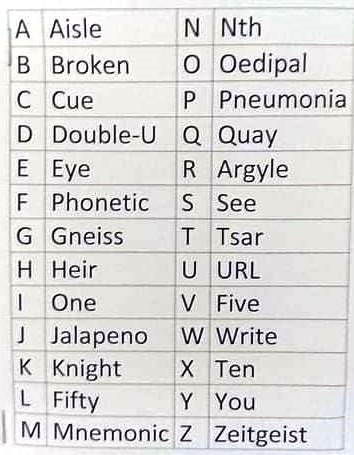One of the first things a new ham needs to learn when they get on the air is the phonetic alphabet. Because many alphabet letters sound similar over the air (especially in poor conditions), it is helpful to use phonetics when spelling out words or giving your call sign accurately. This is particularly important in emergency communications (EmComm) and when checking into a radio net, which is where many new hams get started.

A good phonetic alphabet is clear, differentiated, and commonly understood, unlike this joke phonetic chart:

These days, amateur radio protocol favors the International Telecommunication Union (ITU) phonetic alphabet, also used in international aviation and the NATO military, making it fairly universal. You are likely to hear other phonetic alphabets on the air but should know the ITU version and use it. Start learning even before you take your license exam so you are ready to go when you get your ticket.
The best way to learn ITU phonetics is to practice. Familiarize yourself with the phonetics and then practice by spelling words out. A great way to do this is while sitting idle at a traffic light or while walking through a parking lot. Just start spelling out signs and license plates phonetically. When you see a stop sign, just say out loud, “Sierra Tango Oscar Papa.”
Note that there are official pronunciations for each character and a few may seem a little odd; this is to accommodate many native languages, not just American English. There are also specific ways of pronouncing certain numbers (niner is the most obvious one) and punctuation. Be advised that the official ITU number pronunciation is very odd (a mixture of languages) and the ones shown below are more common for amateur radio usage.
One good ITU phonetic alphabet link is pasted below.
| Character
A
|
Phonetic
Alfa
|
Pronunciation
ALFAH
|
| B |
Bravo |
BRAHVOH |
| C |
Charlie |
CHARLEE |
| D |
Delta |
DELLTAH |
| E |
Echo |
ECKOH |
| F |
Foxtrot |
FOKSTROT |
| G |
Golf |
GOLF |
| H |
Hotel |
HOHTELL |
| I |
India |
INDEE AH |
| J |
Juliett |
JEWLEE ETT |
| K |
Kilo |
KEYLOH |
| L |
Lima |
LEEMAH |
| M |
Mike |
MIKE |
| N |
November |
NOVEMBER |
| O |
Oscar |
OSSCAH |
| P |
Papa |
PAHPAH |
| Q |
Quebec |
KEHBECK |
| R |
Romeo |
ROWME OH |
| S |
Sierra |
SEEAIRAH |
| T |
Tango |
TANGGO |
| U |
Uniform |
YOUNEE FORM |
| V |
Victor |
VIKTAH |
| W |
Whiskey |
WISSKEY |
| X |
X-ray |
ECKSRAY |
| Y |
Yankee |
YANGKEY |
| Z |
Zulu |
ZOOLOO |
| 0 |
Zero |
ZEE-RO |
| 1 |
One |
WUN |
| 2 |
Two |
TOO |
| 3 |
Three |
TREE |
| 4 |
Four |
FOW-ER |
| 5 |
Five |
FIFE |
| 6 |
Six |
SIX |
| 7 |
Seven |
SEV-EN |
| 8 |
Eight |
AIT |
| 9 |
Nine |
NIN-ER |
The official ITU chart is found here >> ITU phonetic chart
For a tad more fun we present a pictorial-enhanced ITU phonetics chart, author unknown:



